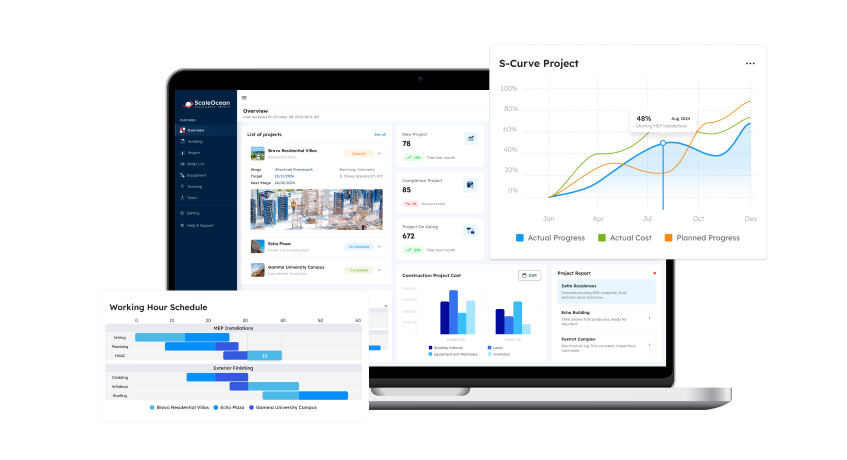Managing project costs effectively can be a challenge, especially in complex industries like construction. A project’s budget can quickly be exceeded without a clear structure in place, which can cause delays and financial losses. This is where the Cost Breakdown Structure (CBS) comes in.
A cost breakdown structure (CBS) is a framework that organizes project costs and is a key instrument for managing money. The CBS provides a detailed framework for organizing and controlling costs, ensuring that every expense is accounted for. To manage construction costs in Singapore, the CBS plays an important role in keeping projects within budget.
Businesses can enhance financial planning and lower the chance of overspending by understanding the project management cost breakdown structure. This understanding will help in the effective completion of projects.
- A Cost Breakdown Structure (CBS) is an organized framework that categorizes project management overall costs into distinct segments to monitor and control expenditures efficiently.
- Examples of cost breakdown structures include: labor, material, equipment, overhead, subcontractor, and utility cost.
- To create CBS, first define the WBS, identify cost categories, and estimate costs. creates the CBS, and lastly, tracks and monitors costs.
- The benefits of CBS are improved cost control, better budgeting, enhanced resource allocation, facilitated cost tracking and reporting, better decision-making, also risk mitigation.

What is Cost Breakdown Structure (CBS)?
A Cost Breakdown Structure (CBS) is an organized framework that categorizes a project’s overall costs into distinct segments, enabling project managers to monitor and control expenditures efficiently. Its purpose is to provide project managers with a detailed perspective on project expenses, facilitating improved cost management, budgeting, and resource distribution. Implementing construction cost management software can enhance the effectiveness of a CBS by providing real-time data and insights for better decision-making.
CBS classifies expenses into distinct categories, including labor, materials, equipment, overhead, and various other costs. This structure helps project managers allocate resources more effectively and monitor expenses throughout the project’s lifecycle, aligning closely with the general ledger for comprehensive financial tracking.
By providing a clear, detailed view of where money is being spent, CBS ensures better cost control, aids in budgeting, and minimizes the risk of overspending. CBS is particularly helpful in sectors like construction, where keeping track of different costs is important to the completion of a project.
Benefits Cost Breakdown Structure

The failure of one or both might put the project’s success at risk. Managing the contract lifecycle effectively alongside the project timeline ensures that contractual obligations align with these financial and scheduling goals of construction, further reducing risk. Here are the benefits of CBS in Singapore companies:
1. Improved Cost Control
CBS enables project managers to identify potential cost overruns and take corrective actions, and tracking of individual cost components like labor, materials, and equipment. Companies also can monitor every item closely and make sure there are no unforeseen budget deviations.
2. Better Budgeting
The CBS offers a comprehensive cost assessment, facilitating the development of a practical project budget. This transparency helps project managers create a more accurate and realistic project budget, reducing the risk of underestimating expenses and ensuring better financial management planning. Using tools such as the break even point formula can complement CBS by helping businesses understand the minimum sales needed to cover costs, thus improving overall financial planning.
3. Enhanced Resource Allocation
By comprehending the expenses linked to various tasks, project managers can distribute resources more efficiently. This insight allows for a more effective allocation of resources, ensuring that the right resources are available at the right time and within budget.
4. Facilitates Cost Tracking and Reporting
The CBS facilitates straightforward monitoring of actual expenses in comparison to budgeted costs, allowing project managers to assess project performance effectively. This easy comparison allows project managers to monitor project performance closely, providing valuable insights into cost performance and enabling timely adjustments for successful project delivery.
5. Better Decision Making
With CBS, project managers have clear information about how much money is being spent in each category. With this information, they are more equipped to decide how to reallocate funds, implement cost-cutting strategies, or change the project’s scope without going over budget.
6. Risk Mitigation
By breaking down costs into manageable segments, CBS helps project managers identify potential areas of financial risk, such as underbudgeted categories or unanticipated costs. Early identification of these risks allows for proactive planning, reducing the likelihood of unexpected financial challenges later in the project.
Also Read: 12 Best ERP Modules for Construction Companies in Singapore
Examples of Cost Breakdown Structure Categories
 Cost Breakdown Structure (CBS) usually includes various costs categorized into various elements, depending on the nature of the project. Understanding this can optimize spending, prevent budget overruns, and improve financial planning. The following are cost categories in CBS in construction:
Cost Breakdown Structure (CBS) usually includes various costs categorized into various elements, depending on the nature of the project. Understanding this can optimize spending, prevent budget overruns, and improve financial planning. The following are cost categories in CBS in construction:
1. Labor Costs
Labor costs include wages, overtime, and benefits for all workers directly involved in the construction project, such as carpenters, electricians, and site managers.
It can also extend to salaries for on-site administrative staff and engineers.
Precise labor tracking guarantees that unanticipated increases in labor requirements will not cause the project to go over budget.
2. Materials Costs
Material costs are raw materials, parts, components, and other materials used in the project. This cost expenses for all physical materials used in the construction project, from structural elements like steel beams and concrete to finishing materials like paint and tiles. It can change depending on market conditions, therefore thorough tracking is required to avoid overruns and maintain timely procurement.
3. Equipment Costs
Cost of equipment used in the project, including rental fees and maintenance costs. Heavy equipment such as cranes, bulldozers, excavators, and other specialized tools are necessary for construction operations. With the help of construction cost estimating software, these costs can be more accurately tracked and managed throughout the project.
Equipment costs may involve purchasing new machinery, leasing equipment for the project duration, or covering maintenance and repair expenses. Efficient management of equipment use helps control these significant costs.
4. Overhead Costs
Overhead costs such as rent, utilities, and administrative expenses. This cost also includes office rent, utilities, insurance premiums, and project management software. While they are not directly related to building operations, they nevertheless need to be included in the project’s overall cost to present a whole financial management picture.
5. Subcontractor Costs
CBS in project management often involve subcontractors to assist their projects. Hiring subcontractors, such as electricians, plumbers, and roofers, is frequently necessary for specialized work.
Each subcontractor has a separate contract with the main contractor. Their costs must be tracked individually to ensure services are delivered within the agreed budget and time frame.
6. Utility Costs
Utility costs refer to the expenses involved in connecting the project to necessary utilities like water, electricity, gas, and sewage. These costs can also include temporary utilities needed during construction, such as generators and temporary water lines, which are essential for site operations.

How to Create a CBS?
To create a CBS, begin by developing a detailed Work Breakdown Structure (WBS) to identify all project tasks. Next, determine the cost drivers for each task and estimate the associated costs. Finally, categorize the costs according to the CBS structure to ensure an organized and comprehensive breakdown.
For efficient budget management, a Cost Breakdown Structure (CBS) must be created to classify project expenses into distinct, comprehensive groups. These steps are important to improve financial transparency by methodically breaking down expenses. To create a CBS business, follow these steps.
1. Define Project Scope and Objectives
Start by thoroughly understanding the project’s overall scope, including deliverables, timelines, and key objectives.
This helps to verify that all cost-related actions are consistent with the overall project goals.
By having a clear project scope, you can anticipate potential costs and prevent overlooking important financial components.
It also helps to establish the CBS as a means of attaining the project’s financial objectives, which is closely related to how to get financial goals for business in a structured and practical way.
2. Identify Cost Categories
After the scope is clear, identify the broad cost categories relevant to your project. In construction, this usually includes labor, materials, equipment, subcontractor services, permits, and overhead cost.
The objective is to develop an ordered structure that covers all parts of the project. By selecting these high-level categories, you can ensure that nothing is overlooked during the process of budgeting.
3. Break Down Categories into Subcategories
To gain more precision, break each major category into detailed subcategories. For example, separate costs for engineers, site workers, and project managers who are under labor.
Under materials, specify costs for different materials like steel, wood, and concrete.
This level of accuracy enables the tracking, monitoring, and management of expenditures throughout the project. Breaking things down also helps discover potential cost overruns.
4. Assign Costs to Each Subcategory
Use data-driven methods to estimate costs for each subcategory.
This might include analyzing previous project data, obtaining vendor bids, or investigating current market rates.
Assigning accurate costs to each subcategory ensures the CBS reflects realistic financial requirements. It also helps in avoiding the risk of underestimating or overestimating costs, which could affect the project’s budget and timeline.
5. Allocate Contingency Costs
CBS in project management includes contingency costs, and a safety net for unexpected expenses. Allocate a certain amount of the budget to cover potential risks such as material price variations, unscheduled overtime, or weather-related delays, which are essential for effective cost control in business.
It is generally recommended to keep 5-10% of the total project cost as a contingency. This ensures the project can absorb unexpected financial pressures without going over budget.
6. Review and Validate Costs
After completing the CBS, it is important to have it reviewed by stakeholders, such as financial controllers, project managers, and contractors.
Validation ensures that cost estimates are accurate, thorough, and in line with the project’s goals. This step also allows for cross-checking of estimates, spotting any overlooked categories or subcategories, and ensuring everyone involved agrees with the budget framework.
7. Monitor and Update the CBS
The CBS is not static and must be updated regularly as the project progresses. Compare actual expenditures to estimated estimates in real-time to identify any disparities early on.
If the project scope changes or unexpected costs arise, the CBS should be modified to reflect the new financial condition. This ensures continual cost control, maintains the project on budget, and provides stakeholders with transparency.
Cost Breakdown Structure Example
A CBS example provides a clear framework for categorizing and managing project expenses, ensuring better cost budget control. You can gain a structured view of their financial allocations by breaking costs down into specific components. Below is an example of a CBS for a construction project.

A Cost Breakdown Structure (CBS) is a hierarchical representation of all project costs used in project management to track and control spending. It divides project expenditures into smaller portions, allowing project managers to better monitor financial elements.
You can use some tools for creating a CBS including spreadsheets for organizing cost data, project management software for tracking tasks and budgets, and construction accounting tools to manage financial aspects and ensure accurate cost allocation throughout the project.
ScaleOcean ERP modules for construction companies with Project management features is the best solutions that you can use with an offer that optimizes the Cost Breakdown Structure (CBS) by integrating powerful tools like project management software, construction accounting tools, and automated cost tracking features.
These tools provide real-time visibility into project budgets, resource allocation, and expenses, ensuring efficient cost management. By streamlining processes that would traditionally rely on spreadsheets, ScaleOcean enhances accuracy, minimizes manual errors, and enables teams to stay on track with project timelines and budgets.
Simplify CBS with ScaleOcean Construction Software

ScaleOcean Construction Software makes cost breakdown structure in project management easier by offering a highly integrated, efficient, and customizable approach tailored to the needs of the construction industry.
This construction software allows you to create precise budget plans, including work-in-progress (WIP) and construction-in-progress (CIP) accounting. It provides accurate and real-time cost tracking for each phase of a construction project. This real-time integration helps companies manage all aspects of their budget more effectively.
One of ScaleOcean ERP modules is the ability to generate cost breakdown structures, that include all project details from materials to resources, ensuring that all costs are considered from the start.
Furthermore, ScaleOcean integrates seamlessly with other project management modules, guaranteeing that changes in the building project are logged and available for future analysis and reporting. This level of integration supports companies in staying on budget, managing resources effectively, and preventing project delays caused by inefficient cost management.
ScaleOcean offers a comprehensive solution that covers all aspects of building project management, allowing companies in Singapore to avoid the dangers of fragmented data and manual processes. scaleocean also offers free demo services, consultations with professional teams, and even after-sales services to optimize system implementation in your construction company.
Conclusion
Cost Breakdown Structure (CBS) is an essential tool for managing project expenses effectively. Breaking down costs into clear categories like labor, materials, and equipment, provides greater control and transparency, especially in complex projects such as construction company in Singapore
For Singapore enterprises dealing with construction expenditures, adopting a well-organized CBS helps projects stay within budget and on schedule. ScaleOcean software construction offers a powerful implementation solution tailored for companies in Singapore, helping streamline cost tracking, improve budget accuracy, and enhance decision-making.
With automated cost categorization and real-time analytics, businesses can eliminate inefficiencies and prevent budget overruns. Start optimizing your CBS today with ScaleOcean and take control of your project costs with precision. Take a free demo now and maximize your business operations up to 100% across the board.
FAQ:
1. What is the cost breakdown structure?
The cost breakdown structure (CBS) defines the levels at which project costs are collected. It allows budgets to be set, and ensures costs are accurately recorded, controlled, and tracked. This structure helps manage expenses across various project stages for better financial control.
2. What is CBS and WBS?
The Cost Breakdown Structure (CBS) organizes costs for the various components outlined in the Work Breakdown Structure (WBS). While the WBS is typically defined by the project management team, the CBS is defined by the finance or commercial department to ensure proper cost allocation and tracking throughout the project.
3. What should be included in a cost breakdown?
A cost breakdown divides project expenses into categories like labor, materials, overhead, and other costs. This detailed structure helps identify areas for cost savings and allows for comparing expenses across different projects, ensuring effective financial management and decision-making.
4. What does CBS stand for in procurement?
In procurement, CBS (Cost Breakdown Structure) is a critical framework used to categorize and manage costs, playing a key role in supply chain management. It includes various practices, procedures, and strategies that ensure effective financial oversight and operational efficiency in business operations.







 PTE LTD..png)
.png)

.png)








.png)
.png)
















